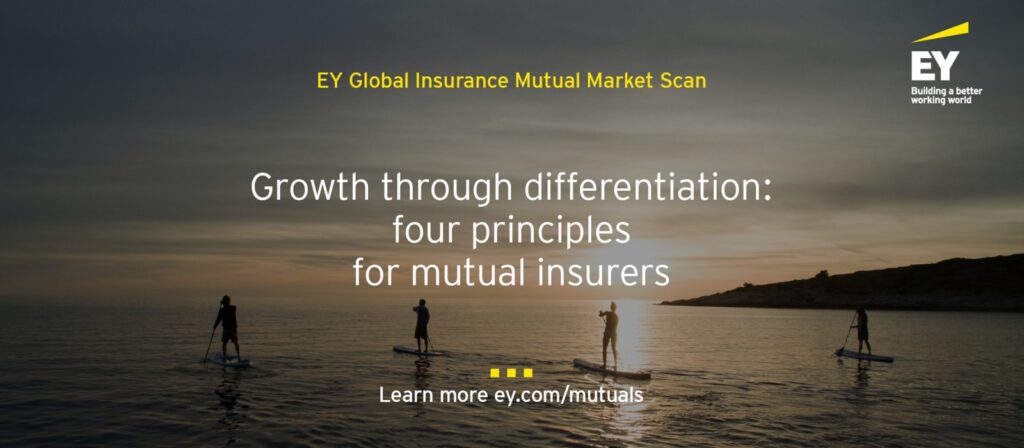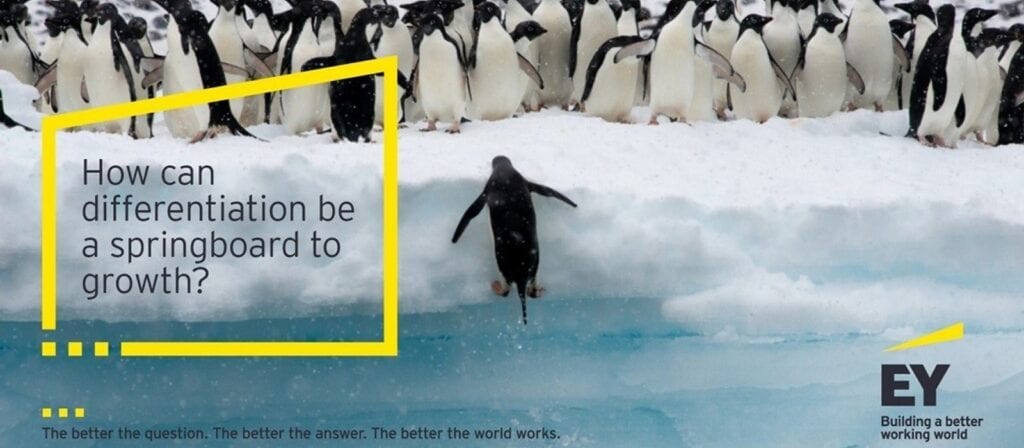This guest blog was written by Jennifer Baziuk, Associate Partner, Business Consulting, Business Transformation and co-authored by Jay Zealand, Manager of Business Architecture and Melanie Reixach-Wong, Business Consultant at ICMIF Supporting Member EY.
EY’s four principles of mutual differentiation were established from market and organisational insights. These insights were obtained through collaboration with EY’s global network of subject matter advisors; EY’s Global Mutual Insurance Market Scan, including 140 participants across +35 countries; a deep-dive assessment of mature mutual markets; and an analysis of 50+ mutual/cooperative case studies (including many ICMIF member organisations) using the EY Mutual Framework.
Mutual and cooperative insurers represent an important and growing sub-segment of the overall insurance market, with some of the most prominent and successful brands in the industry. Mutual and cooperative insurers (hereafter referred to as “mutuals”) are better capitalised than their stock insurer counterparts and grow at marginally higher rates, though they run underwriting losses some years due to their practice of paying dividends to policyholders.
Based on analysis from ICMIF, mutual insurers account for approximately 27% of the global insurance industry market share. Over 5,000 mutual, cooperative and member-owned insurers generated more than USD 1.2 trillion in gross written premiums in 2017 and achieved a 30% growth in premiums in the 10-year period since the onset of the financial crisis (2007 to 2017), compared to 17% growth of the total global insurance industry.
Just as the strategic priorities of stock carriers are changing, mutuals also face an evolving landscape, with fast-rising customer expectations, new competitive threats and disruptive technologies – all issues at the top of C-suite and board agendas across the insurance industry.
To understand the most important imperatives for mutual and cooperative insurers and define just what sets them apart from stock carriers, EY conducted an extensive scan of the mutual market during 2020. Specifically, we looked at how mutuals of all sizes and types devise and operationalise purpose-led strategies to differentiate themselves and accelerate growth. Indeed, mutuals seem uniquely well positioned in an era where purpose and long-term value creation have become strategic imperatives for the entire industry.
From this research, we identified four core principles that differentiate mutual insurance companies from stock carriers. Collectively, these principles represent a strategic playbook for mutuals to find success in the dynamic, technology-enabled and purpose-led insurance industry of the future.
Principle 1
Driving a purpose-led strategy is rooted in long-term thinking and value, over profitability
In order to operate with community orientation top of mind, insurers must display social responsibility-focused values, decision making, and behaviour where managers place a strong emphasis on increased community welfare.
To achieve this, there are two underlying themes that should be highlighted:
- Embodying a long-term focus for strategic planning rather than a short-term outlook. A long-term purpose-led strategy and operating model reflect community giving and focus on four pillars: human wellness, member value, societal impact, ecosystem productivity.
- Secondly, these four pillars of long-term value are reflected in strategic KPIs, which measure overall impact and are tied to financial results.
Examples of case studies found in the market include:
- An Australian mutual that was centered around servicing the community through education and making decisions that would support early educator segments which are often unprofitable. The mutual worked closely with underserved early educator communities with the vision they would become long-term value customers.
- The Canadian market is providing a variety of flexible product offerings for farmer communities. Insurers are offering personalised SME insurance to farmers and family-owned businesses. These offerings emerge from a deep understanding and commitment to serving communities outside of the core member base.
Principle 2
Being member-centric requires an owner engagement model that is unique from customer engagement
Mutuals focus on a specific niche and owner-centric model that benefits the long-term health of the organisation and members, versus stock carriers who are focused on short-term returns for shareholders through a solely customer-centric focus. Mutuals often refer to their members as both customer and owner, however, delineate a distinct difference between owner and customer as stakeholders and use personalised engagement strategies to access both groups. Mutual members are always customers, while for some mutuals, members are also owners. Mutuals that can drive strong engagement and create value for their members have distinct engagement strategies and tactical initiatives that support a member acting as an owner versus a customer.
– Therefore, by definition:
- Customer-centricity is focused on driving a seamless and engaging experience through the value chain (eg underwriting, claims, post-claims) for members that purchase and own mutual products.
- Owner-centricity views the member as an owner and takes a long-term focus, including involving members in decision-making around strategic direction and maintaining a not-for-profit mindset.Examples of case studies found in the market include:
• A French mutual whose owner strategy sets members as voters for electing a member representative on the board. Its customer strategy has an unrelenting focus on customer experience seen through a churn rate of 1-2% and being #1 in claims handling.
• A Swiss mutual whose owner strategy involves inviting members to its annual general meeting to provide input on strategy, while the mutual’s customer strategy focuses on benefits through customer experience and premium reductions.
• A UK mutual has brought its customer base into its governance structure by integrating a farmer onto its Board of Directors to provide an agricultural perspective and insights on farming community needs.
Principle 3
Value creation for core member segments and periphery segments are critical to achieving growth and innovation
- The idea that value creation for a mutual’s core and periphery member base is especially true for mutuals with large market shares in their regions. Typically, when a mutual’s member base grows rapidly beyond its core member segment, the mutual reaches a crossroad between establishing large growth initiatives in the market and staying close to their purpose-led strategy. Two key aspects arose for mutuals looking at defining their growth and innovation strategy: changing product offerings and customer experience for core members to create more value and growth. Specifically, many large mutuals are taking a segmentation and tiering-based approach to their members, often tiering based on alignment to core purpose and calculating decisions based on member lifetime value for members that fall within tiers closest to that purpose. This was seen in Australia and North America among mutuals that were originally established to service the education sector where flexible propositions were created to attract early educator segments.
- Growing new revenue sources beyond the core member base with offerings closely tied to the core members’ community and ecosystem. This was seen in North America and France with farm mutuals that continue to find ways to service more of their farmers and expand their share of wallet while also finding new ways to innovate and grow in the market.
Examples of case studies found in the market include:
- A US auto insurer provides regular cash dividends and surplus allocations to member tiers dependent on the product held. In 2018, the mutual provided auto policyholders with a 5% credit on policy renewal, as well as a special 5% cash allocation.
- A large Swiss mutual insurer redistributes non-life profits on a two-yearly schedule, alternating between allocating a share of their profits to motor insurance policyholders one year and to third-party liability/property insurance the next year through premium reductions.
- A large British mutual’s Board decides annually whether a dividend should be paid and which members should receive it, based in part on the product class held by the member.
Principle 4
Social and economic change across local communities and underserved segments is fundamental to brand and purpose
The 2021 EY Global Consumer survey found that over 70% of personal and small business lines consumers in select regions indicated that a carrier’s commitment to social and environmental change was a key factor in their purchasing decision, which becomes a critical advantage in a mutual’s brand articulation, especially in a hard market.
To be successful in this principle, four considerations are key:
- Greater focus should be dedicated to defining what social impact means for mutuals, given grassroots movements and the ability to service core needs of community. As such, mutuals are in a great position to embed ESG in their greater purpose, offering and strategy.
- Inclusive insurance in both emerging and developed nations continues to be a focus for mutual insurers, many of which are striving to understand how to continue to serve underserved populations in a profitable way.
- Defining and communicating what social issues are part of each mutual insurer’s member base is critical.
- Various social KPIs are being used in the market, some of which include: % insured below the poverty line, % of minorities insured, % of insured at retirement age or above, and the social investment ratio. Oftentimes, these metrics are directly tied to strategic activities and financial measures within the mutual as well.
Examples of case studies found in the market include:
- A Singaporean mutual partnered with an InsurTech to accelerate digital innovation and reach customers who are less receptive to traditional insurance offerings and distribution channels.
- A US mutual developed an in-house, online community that allows its employees to submit ideas, participate in company challenges, and collaborate with peers on solution development.
As with stock carriers, mutual insurers find themselves in a unique position in the post-COVID-19 market. Indeed, now is the time for mutuals to be bold with their growth strategies, identifying new opportunities where their purpose-led brands can gain traction and new segments they can serve. They must seek to harness the differentiating power of their purpose and customer-centricity to meet the moment. Thanks to the increased awareness of the savings and protection gaps, economic inequality and the emergence of stakeholder capitalism, all insurers – but especially mutuals – can demonstrate their value and relevance at greater scale than ever before.






